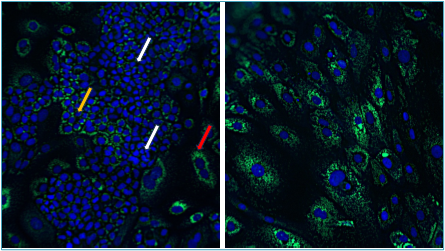FOCUS #9: Keep shining: the role of the sebaceous gland in skin ageing by Phenocell
5 December 2023
Skin is a mirror of the aging process living organisms go through. Over time, significant aging-associated changes occur in several skin cell types, including keratinocytes, melanocytes, fibroblasts and sebocytes.
Sebum is needed at the surface of the skin
Produced by the sebaceous gland, sebum is instrumental to skin health. Besides its barrier function to protect skin from ultraviolet rays and dehydration, sebum has antioxidant and antibacterial properties, and is involved in the transport of pheromones. Sebaceous glands are particularly abundant in the face, ears, scalp, and upper part of the trunk, which are most exposed to UV and, as such, are involved in specific skin disorders (acne, epidermomas,…) and in physiological aging of the skin.
Sebum secretion is regulated by a number of agents that include androgens, estrogens, cholesterol, PPARs, melanocortin, some growth fators and retinoids. Due to alterations of both internal (neuro-endocrine system, increased oxidative stress, diet, sleeping rhythm, alcohol intake) and external (sunlight exposure, cigarette smoking, environmental pollution) factors, sebum secretion brutally falls about at the end of the fifth decade in women. This results in skin dryness, lack of brightness, xerosis, roughness, desquamation and, ultimately, pruritus.
Sebum quantities and quality change with time
The size and activity of the sebaceous gland is regulated by a pool of proliferative progenitor cells and a resident population of early differentiated sebocytes that lie beneath the basal sebocyte layer, close to the hair duct. The turnover of the sebaceous gland is slowed down in aged skin, due to a decreased proliferative capacity of the progenitors that regenerate the pool of young sebocytes. This phenomenon follows a transient increase in size (hyperplasia) of the gland, which then contains a high number of progenitor cells and less mature sebocytes. This burst in proliferative activity progressively depletes the stem cell pool and ultimately leads to sebaceous gland atrophy.
A closer look at molecular mechanisms involved in aging of the sebaceous gland have identified age-related alterations molecular mechanisms that include Wnt/β-catenin, c-Myc, aryl hydrocarbon receptor (AhR), and p53 signaling pathways. A dramatic down-regulation of the PPARg gene is observed in the aged sebaceous gland, in correlation with loss of differentiation activity of resident cells. β-catenin-dependent transcription is down-regulated by the activation of androgen receptors, leading to maintenance of sebocytes differentiation and sebum production. With the decrease of hormones production, the β-catenin pathway is reactivated, leading to cell and gland hyperplasia and decrease in sebum production. On the external factors side, the TGF-β/Smad pathway is triggered by UVB irradiation, resulting in downregulation of sebocytes differentiation and inhibition of sebum production.
In conclusion, skin aging is highly dependent on the sebaceous gland physiology, which is controled by genetic factors, neuroendocrine system variation, specific skin diseases and extrinsic factors.
Analyzing sebocyte behaviour to prevent skin aging
In skin aging research, a majority of efforts have been put into characterizing agents able to maintain skin elasticity, reduce wrinkles, maintain skin tone and texture, and preserve skin brightness, based on responses of primary keratinocytes and fibroblasts. Mainly associated with acne disorders, the sebaceous gland has been put aside priorities in the quest for anti-aging agents. However, hormonal replacement therapy is a direct influencer of the sebaceous gland function. It increases sebum levels and improves skin dryness in menopausal women, indicating the importance of considering sebocytes when developing anti-aging formulations.
Phenocell has developed a reliable production line of human sebocytes, using induced pluripotent stem cells (iPSC). The iPSC technology allows the production of unlimited amounts of sebocytes from a variety of ethnicities. As illustrated in Figure 1, the iPSC technology allows the analysis of sebocytes behaviour all along the differentiation process, i.e. stem cells, progenitors, young and fully mature sebocytes.

Figure 1. Human iPSC-derived sebocytes at early (A) and late (B) stages of maturation. White arrows show the pool of progenitor cells, the yellow arrow shows early sebocytes, the red arrow shows mature sebocytes charged with lipid vesicles (green dots). The proportion of large, fully mature cells increases with aging of the culture. Scale bar: 50 µM.
Population-specific skin aging
Europeans, Asians, American and African individuals present different characteristics of skin and skin aging. Caucasians have an earlier onset and greater skin wrinkling and sagging signs than other skin types, while in Chinese women wrinkle oinset is elayed by about 10 years compared to Caucasian women. Sebaceous secretion also varies among ethnies. African American and Caucasian women display higher skin dryness than other populations. Investigations on the role of sebum secretion in aging among populations is very limited. PCi-SEB are available in 3 different ethnicities and represent a unique tool to perform aging investigations.
👉 To review this topics through the 50 articles published in the Skinobs News feed and Press review: click here
👉 To find out more about Phenocell expertise: click here
CONTACT
Helene Leménager






 Follow us on Linkedin!
Follow us on Linkedin!
You must be logged in to post a comment.